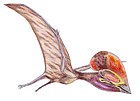|
Pangupterus
Pangupterus (meaning Pangu wing) is a genus of pterodactyloid pterosaur from the Early Cretaceous Jiufotang Formation of China. It was first described and named by Lü Junchang et al.[1] It is known from a mostly-complete lower jaw, which bears 36 slender, evenly-spaced, conical teeth jutting out at an angle on its tip. Some teeth are smaller than the others, and appear to be replacement teeth. The teeth had a relatively high density of over 4 per centimetre (10/in), although the spaces between the teeth were wider than the diameter of the teeth themselves.[2] Such teeth are not seen in any other toothed pterosaurs from the Jiufotang Formation with comparable material, and this specialized dental morphology is indicative of a piscivorous lifestyle.[1] Although no phylogenetic analysis was conducted to determine its affinities, Pangupterus has a small process, called an odontoid, on the end of the maxilla; such a process is also seen in the istiodactylids Longchengpterus and Istiodactylus.[1][3] In 2022, Chang-Fu Zhou and colleagues identified Pangupterus as a member of the Ctenochasmatidae without comment.[2] References
Information related to Pangupterus |
||||||||||||||||||||||












